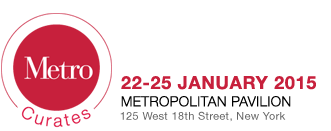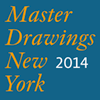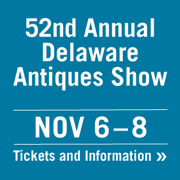2015 Metro Show Booth Talks
THURSDAY
 2 pm Federico Uribe’s World
2 pm Federico Uribe’s World
Adelson Galleries, Booth #216
Adam Adelson will discuss his booth, which is transformed into an environment of re-purposed, “up-cycled” materials that reflect artist Federico Uribe’s view of the world. Each animal or flower that the artist creates contains its own life that can be felt individually. Taken as a whole, viewers are transfixed by the new purpose that these items acquire. Using a variety of unconventional objects to create his artworks, Uribe’s central goal is to make viewers smile.
4 pm Cross Cultural Threads
John Molloy Gallery, Booth #117
In their presentation for Metro Curates 2015, John Molloy Gallery seeks the common thread between contemporary art and Native American Material. John Molloy will explain the gallery’s curatorial intent, which is to show art and artifacts that share the motif or mysticism inherent in museum quality antique native American Art. Plains Indian beaded regalia is presented alongside the contemporary animal totems of Mark Kindschi. Historic Native American masks enrich the recent snakeskin and honeycomb masks created by Mariano Chavez. A comparison is made between contemporary master James Havard’s strong figural paintings and ancient Inuit walrus ivory figurines, and Larissa Nowicki’s sublime paper weavings and the classic beauty of 19th century Navajo textiles. Hopi Kachina dolls are complimented by the intricate bird drawings of Tony Fitzpatrick. These cross cultural commonalities can be unexpected and obscure, but each work of art is enriched and reinforced by its company.
 6 pm BIRDS BURL BRANCHES & BARK
6 pm BIRDS BURL BRANCHES & BARK
Joshua Lowenfels and Steven S. Powers, Booth #101
Joshua Lowenfels and Steven S. Powers will give a talk on their booth presentation, BIRDS BURL BRANCHES & BARK, a collection of paintings, folk art and sculpture from the 19th-21st centuries, curated around the loose theme of flora and flying fauna.
Powers’ aesthetic flirts with the traditional, however walks the line of the unexpected and unorthodox, while Lowenfels is well established in the unpredictable, incidental and surprisingly sublime.
FRIDAY
 2 pm Black Forest Carvings
2 pm Black Forest Carvings
Leatherwood Antiques Booth #315
Mo Waselfish will lecture on 19th Century Black Forest carvings, which were usually of animals or natural objects, and as a symbol of wealth and luxury were collected by Royalty and Victorian world travelers.
 4 pm Antique American Flags, Patriotic Textiles and American Folk Art
4 pm Antique American Flags, Patriotic Textiles and American Folk Art
Jeff R. Bridgman American Antiques, Booth #301
Jeff R. Bridgman will discuss his area of specialization – American Flags, Textiles and Folk Art, using examples from his booth.
 6 pm A Legacy in Tramp Art
6 pm A Legacy in Tramp Art
Clifford Wallach, Booth #310
Clifford A Wallach, author of three books on tramp art, will be addressing his quest for answers from the early days when the art form was sorely misunderstood to how it has become a respected and admired part of the art world today. He will also discuss living with tramp art and how artists – both contemporary and historical - in today’s technology infused world, have or would have adapted to their craft.
SATURDAY
 5:20 pm Two American Surrealists
5:20 pm Two American Surrealists
Susan Teller Gallery, Booth #209
Two American Surrealists: William Baziotes and Hugh Mesibov
Susan Teller will present the work of to artists: Williams Baziotes (1912-1963) and Hugh Mesibov (born 1916)– both born and raised in Pennsylvania, and moved to New York City as young artists.
William Baziotes came to NYC in 1933. His drawings on view at Metro Curates are from 1936 to 1940 when the country was still in the throes of the Depression and World War II was on the horizon. These drawings reflect those dire years: Years in which he met and became friends with the Europeans Giorgio de Chirico, Andre Masson, Roberto Matta, and Americans Gerome Kamrowski, Robert Motherwell, and Jackson Pollock. Hugh Mesibov, who turned 98 the last week of December, was a figurative-genre artist on the Philadelphia WPA Printmaking Program in the 1930s, but with a modern, sketchy drawing style. During WWII he worked in Gramp’s Shipyard, a brutal place to work, and he produced a body of paintings that reflect both his own environment and the tragic world situation. In 1945 he came to NYC where he gradually moved into Abstract Expressionism.
 5:45 pm Jaquard textiles
5:45 pm Jaquard textiles
Umbrella Arts. Bodell.Fahey., Booth #201
What do weaving and physics have in common? In her work Annette Cords draws on diverse sources and combines unlikely materials and ideas. Find out more about the unique process of Jacquard weaving and the inspirations behind Annette’s work.
 6:10 pm Points of Entry
6:10 pm Points of Entry
Douglas Dawson, Booth #303
Douglas Dawson will talk about the historic relationship between tribal art and modern art beginning with the European artists in the early 20th century and how their experience both determined the ‘value’ of tribal art and how the relationship between contemporary and tribal has changed today. He will discuss the current interest and market, what fuels it, and how he sees the future for the ethnographic art market, using pieces in his booth as examples to illustrate various points.
6:30 pm Collecting Without Borders
Cavin-Morris, Booth #107
This talk, given by gallery owner Randall Morris, will focus on the booth’s presentation of non-mainstream art, contemporary art and arts of the ethnosphere, including: rare Asian masks from Japan, the Himalayas and New Guinea; Art Brut, Art Singulier; and sculptural contemporary ceramics and basketry from Japan and the West.
SUNDAY
1 pm Al Farrow: Wrath and Reverence
Forum Gallery, Booth #204
Forum Gallery’s Bob Fishko will give a talk focusing on the works of Al Farrow.
Born in Brooklyn, New York, Al Farrow has lived in the San Francisco Bay Area for more than thirty years. An accomplished sculptor in a wide variety of media, Farrow generally adopts the language of a particular historical period for his work, updating the imagery or material to make cogent observations about contemporary society. In recent years he has used munitions—bullets, guns, hand grenades, bombs—to make three-dimensional projects that resemble Christian reliquaries, Islamic mosques and Jewish synagogues.
 1:30 pm The Art of Collecting
1:30 pm The Art of Collecting
Marion Harris, Booth #115
Collecting has always been part of human culture, and the concept was elevated when the Renaissance in 16th century Europe inspired the introduction of cabinets of curiosities, which were not necessarily pieces of furniture but private museums, or “kunstkammer,” displaying encyclopedic collections sought out by those who coveted the rare and wondrous. Marion Harris will discuss collecting, the kunstkammer and her vision for her own exhibit at Metro Curates.






 The name "Larsen" is synonymous with 20th century textiles. Ever since Jack Lenor Larsen, Inc. was established in 1952, the influence of its innovative, farseeing founder has permeated the field of interior design. Ranging from filmy casement cloths to plush upholstery, from the formal geometry of complex doubleweave to the freshness of colorful organic prints, Larsen textiles have enhanced walls and floors of large company headquarters, educational institutions, jet planes, and private homes.
The name "Larsen" is synonymous with 20th century textiles. Ever since Jack Lenor Larsen, Inc. was established in 1952, the influence of its innovative, farseeing founder has permeated the field of interior design. Ranging from filmy casement cloths to plush upholstery, from the formal geometry of complex doubleweave to the freshness of colorful organic prints, Larsen textiles have enhanced walls and floors of large company headquarters, educational institutions, jet planes, and private homes.